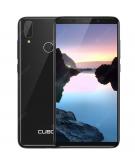Do you want to know more about the Cubot J7 2GB 16GB? We have already selected all the specifications for you and listed below.
The Cubot J7 2GB 16GB was launched in July 2019. The smartphone comes with a 5,7 inch screen with a resolution of 720 x 1440 pixels.
This Cubot is powered by a MediaTek MT6580 chip with a 1,3 GHz Quad-Core processor. With a thickness of 8.85 millimeters, the device is not too thick. This phone only weighs 0 grams.
The J7 2GB 16GB has a 13 megapixel camera. This number of megapixels is more than enough to print beautiful photos on canvas or to zoom in considerably for details. You can also use the 8 megapixel selfie camera for video calling, for example.
Pros
- 13 megapixel camera
- Fingerprint scanner for quick unlocking
- Face recognition for quick unlocking
- Not too thick with 8.85 millimeters
- (Relatively) new operating system: Android 9.0 (Pie)
- HSDPA, LTE-A support for super fast internet
- Dual SIM
Negatives
- With a 2800 mAh battery you may have to recharge in between
Call & data functions
The Cubot J7 2GB 16GB supports frequencies from international networks with which you can use the fastest LTE-A network. The speed of LTE-A is perfect for watching video on the go via your mobile network, where the speed is often even higher than the WiFi connection at home. Choose a large data package with this device. You can also connect via WiFi at home or at the office.
Dual-sim
This phone is a dual sim device, so you can store two SIM cards in it.
Memory and connection options
The Cubot J7 2GB 16GB has 2048 MB of RAM (2 GB) and 16 GB internal storage . Expandable memory: MicroSD up to 256GB. There is a USB connection, you can use this to exchange data with your laptop or to charge your device. Connecting Bluetooth headsets or car kits is no problem.
Do you take a lot of photos and videos? Then the storage of 16 GB is less suitable. You may need to clean your phone after a while. Furthermore, there are of course possibilities to expand storage in the cloud, such as with Google Drive or Dropbox.
Screen & operation
The phone is operated via the large 5,7 inch touchscreen.The Cubot J7 2GB 16GB can display up to a 16 millions colors. This screen has a resolution of 720 x 1440 pixels. With 282 pixels per inch, this eXtra High density screen is sharp and easy to read. It also takes less effort to look at it for a long time.
Operating system
Android 9.0, also known as Android Pie, is a version of the Android operating system that was released in 2018. It includes a variety of new features and improvements, such as enhanced battery life, support for gesture navigation, and new security features.
Some of the key new features of Android 9 include:
- Adaptive battery: Android 9 introduces a new adaptive battery feature that uses machine learning to optimize battery usage by limiting the power used by apps that are not actively being used.
- App actions: Android 9 introduces app actions, which are predictions of what users are likely to do next based on their context and usage patterns. These actions can appear in the app drawer, search results, and other places, making it easier for users to find and use the apps they need.
- Digital wellbeing: Android 9 includes a new set of tools and features to help users manage their digital habits and improve their overall wellbeing. These tools include a dashboard that shows users how much time they spend on their phone and in specific apps, and a new "Wind Down" mode that helps users disconnect from their phone at night.
- Gesture navigation: Android 9 introduces a new gesture-based navigation system that allows users to control their device using swipe gestures. This new navigation system replaces the traditional on-screen navigation buttons with a single home button that can be swiped to access different functions.

